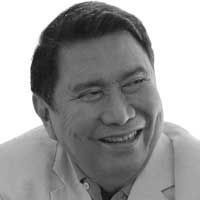Banditry or insurgency

Heavily armed rebels ambushed and killed nine people and wounded three others in a village in the notorious Maguindanao province.
Police say the perpetrators and victims of the ambush belong to rival factions within the Bangsa Islamic Armed Forces-Moro Islamic Liberation Front.
The motive for the bloodbath is rido, or feud, within a clan or feuding families.
If you’re asking the opinion of this columnist, who’s from Mindanao, I say, have them kill each other until the fittest are left standing; then kill the survivors if they still become unruly.
That’s the only way to solve the banditry or insurgency problem in Mindanao.
There’s no other way. The government lacks the manpower and resources to quell the insurgency and banditry in that province’s neck of the woods.
Where did I get such an outlandish idea? From my father, Ramon Sr., who was assigned in Sulu and Lanao in the late 1940s up to the early 1950s as a young officer, and in Sulu as assistant provincial commander in 1964.
My father would arm one faction of a feuding group whose members he called “friendly outlaws.”
Members of the other group were called “enemy outlaws.”
Wherever my father was assigned in any part of Sulu or Lanao, his group was never ambushed; friendly outlaws gave them advance information about an impending attack on their convoy or camp by enemy outlaws.
Because of timely intelligence information, my old man would preempt the plan by the enemy outlaws by attacking their hideouts or camps first.
Remember that at that time there was no Moro National Liberation Front (MNLF) or its outgrowth, the Moro Islamic Liberation Front (MILF).
After the MILF came the Abu Sayyaf, Bangsa Moro Group, Bangsa Islamic Armed Forces and other Muslim or Arab sounding names of armed groups.
Before the MNLF and MILF, there was no unity among the different armed groups.
Filipino Muslims’ love for firearms made them kill each other or use those arms against government troops. It’s been that way ever since; it’s still prevalent now. It’s in their culture or genes.
* * *
You think my father’s idea was original?
Capt. Ramon S. Tulfo copied the idea from American officers who were assigned in Morolandia – the term for Muslim areas – before World War II.
The US government pitted one outlaw group against the other extensively because many American civilians were plantation owners in Morolandia before the War.
The US government treated the Moros fairly, a lesson it learned from dealing with Native Americans who were once called Indians – a term now considered politically incorrect.
Unlike the Spaniards before them who used only sticks, the Americans employed the carrot-and-stick method.
* * *
Pitting an armed group against others, a method still employed in the present day, has disadvantages more than its advantages.
The US government supplied arms to the Taliban to fight the Russians who occupied Afghanistan in the 1980s.
By accident, Osama bin Laden, who became one of the US government’s most wanted men, was a product of America’s support for the mujahideen (Muslim religious freedom fighters) in Afghanistan.
Here at home, the original leaders of the Abu Sayyaf, who were trained by the mujahideen, joined in the fight against the Russians in Afghanistan.
The Ampatuan family, whose members were behind the Maguindanao Massacre, was employed by the Gloria Macapagal-Arroyo administration, supposedly to fight MILF rebels in that area.
Army and police troopers killed 58 civilians, including 32 journalists, on orders from the Ampatuans on Nov. 23, 2009, to prevent their political enemy, the Mangudadatu clan, from registering as candidates for the election of 2010.
Army and PNP men in that massacre were personally assigned by President Arroyo to secure the Ampatuans.
When any member of the Ampatuan family came to Manila from Maguindanao or Davao City, where they had a large residential compound, they were escorted by fully-armed uniformed soldiers and policemen.
Whenever the no-less than 50-strong uniformed men and members of the security forces who wore civvies came to Manila were checked by the police at the airport, they would point to President Arroyo and her husband Mike as their protectors.
The kidnapping-for-ransom and bank-robbery group of the Parojinog family of Ozamiz City was first employed by the military to fight the New People’s Army (NPA).
The group, composed of ex-rebels and retired Army Rangers, started its criminal activities after the military disbanded it. They formed the notorious Kuratong Baleleng kidnap and robbery gang.
From Ozamiz City, the Kuratong Baleleng gang operated in Metro Manila, where they struck fear even among the police.
The high-powered M-14 and M-16 rifles the gang used in robbing banks were issued by the military.
The Parojinogs, who were able to establish a political dynasty in Ozamiz City, was annihilated by President Rodrigo Duterte, who ordered a raid on their house that resulted in the deaths of key family members and the arrest of the others.
The undoing of the Parojinogs was their arrogance.
Their clan patriarch, Reynaldo, mayor of Ozamiz, challenged President Digong to go after them, thinking he would be lenient towards them since they’re from Mindanao.
Duterte became so indignant by the challenge to his authority he at first thought of having Air Force jets or helicopters strafe or bomb the Parojinog mansion.
Digong instead ordered ground troops to attack the Parojinog mansion, a virtual fort, after he was advised some neighbors might get hit by the bombs.
Another group that was employed by the police to go after fellow kidnap-for-ransom gangs was the RSG, or Red Scorpion Group.
The RSG became so notorious in its kidnapping activities that the police employed foul means to disband it, including throwing a sister and niece of the RSG leader, Joey de Leon, from a helicopter flying over Manila Bay.
- Latest
- Trending




























